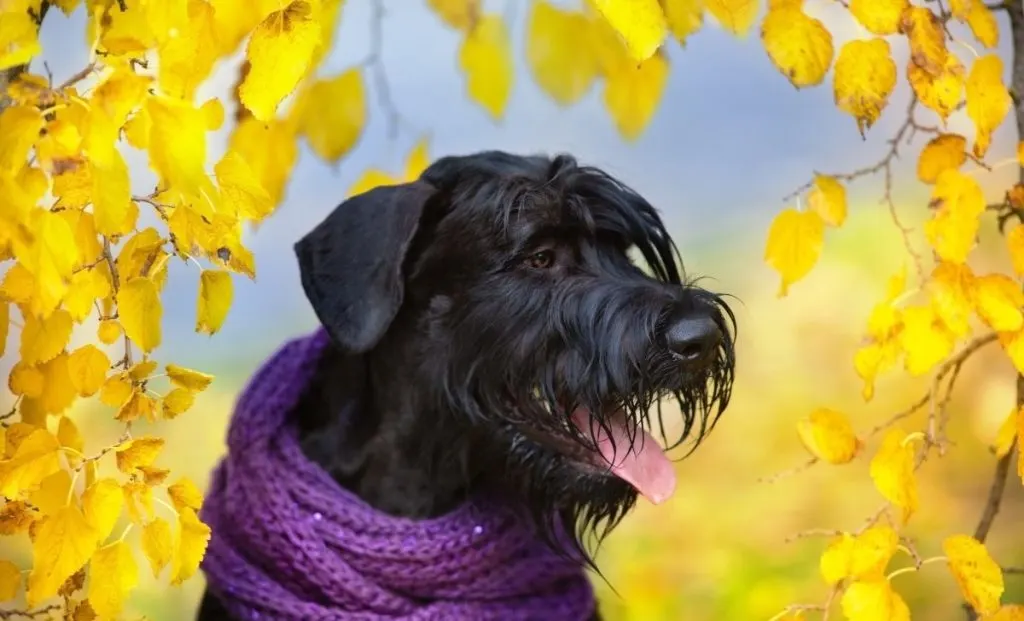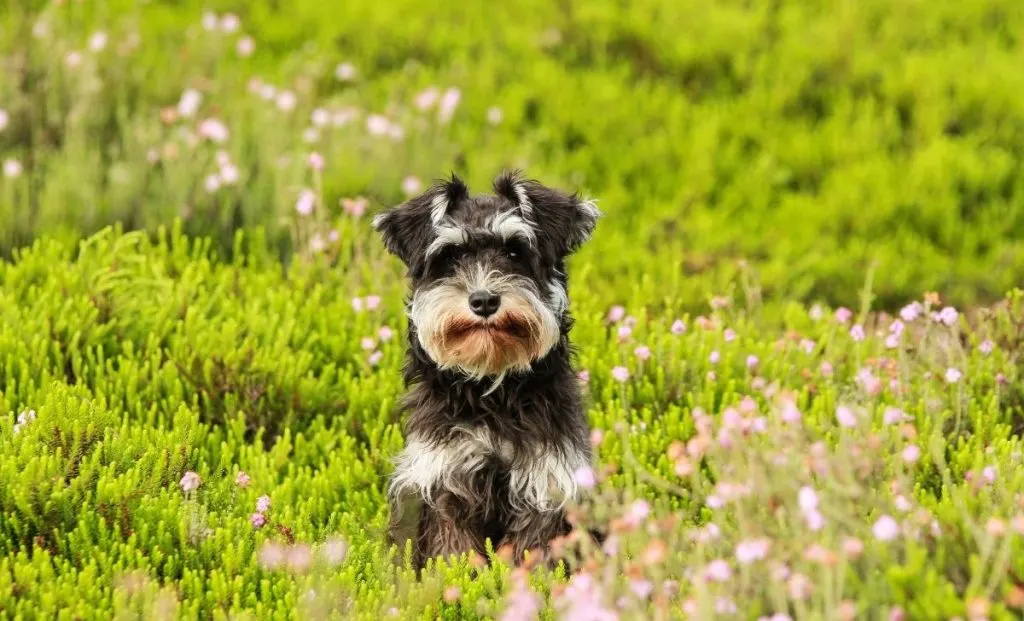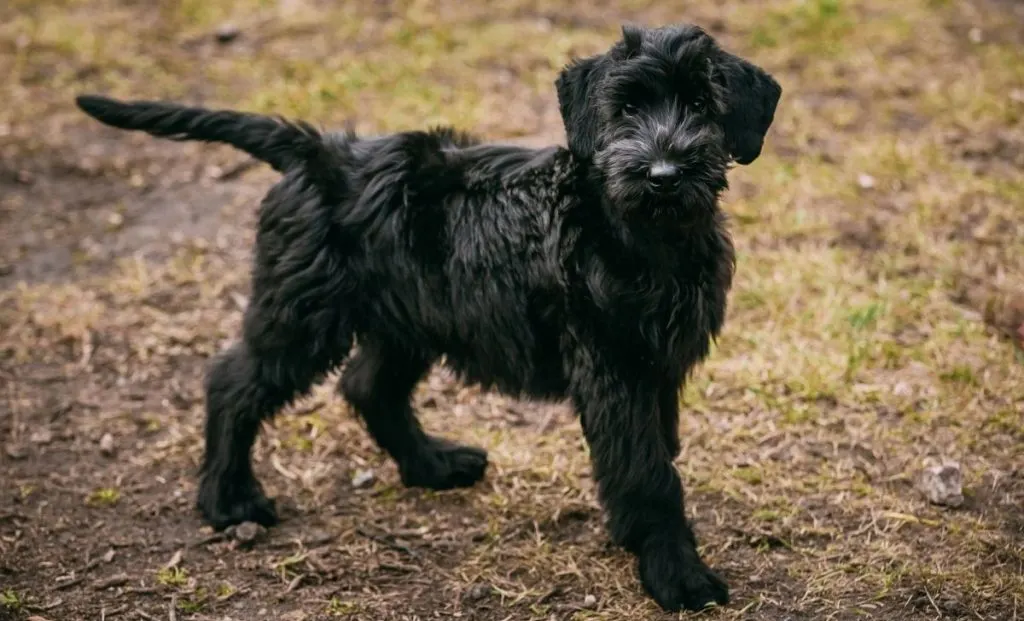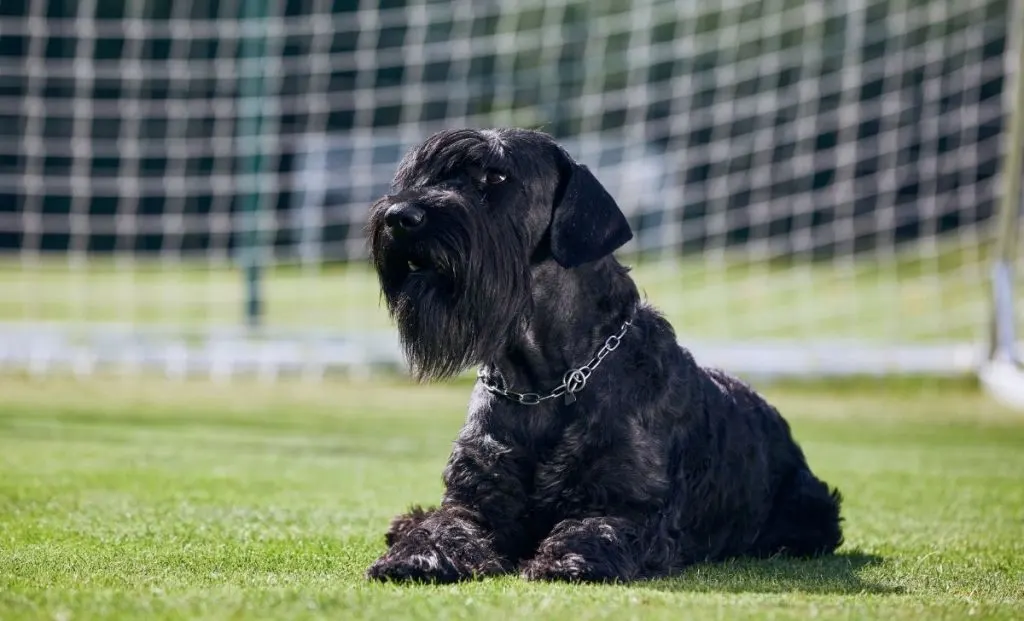Hello there, and welcome to our comprehensive guide on the Giant Schnauzer growth chart.
In this article, we’ll explore some of our favorite canine companions – the Giant Schnauzers! We will follow them from their delicate beginnings as newborn puppies to their robust adulthood.
If you are a new owner, understanding the growth phases of these intelligent and energetic dogs is a must!
Join us and read about the key milestones, factors influencing growth, common concerns, and tips for ensuring your Giant Schnauzer reaches their full potential.
Giant Schnauzer Growth Chart Overview

Growth charts are valuable tools for tracking your Giant Schnauzer puppy’s development.
They provide a visual representation of weight and height changes over time, which help you find out whether your dog is growing at a healthy rate or not.
Such an overview is in the following charts:
Giant Schnauzer Growth Chart Male
Let’s start with the largest individuals – the male Giant Schnauzers. Compared to females, they are usually more robust and sturdy.
| Age (Months) | Weight Range (lbs) | Weight Range (kg) | Height Range (inches) | Height Range (cm) |
| Birth | 1-2 | (0.5-0.9) | 5-7 | (13-18) |
| 1 | 3-5 | (1.4-2.3) | 6-9 | (15-23) |
| 2 | 7-10 | (3.2-4.5) | 8-12 | (20-30) |
| 3 | 10-20 | (4.5-9.1) | 10-15 | (25-38) |
| 4 | 20-30 | (9.1-13.6) | 15-18 | (38-46) |
| 5 | 25-35 | (11.3-15.9) | 17-20 | (43-51) |
| 6 | 30-40 | (13.6-18.1) | 18-22 | (46-56) |
| 7-9 | 35-50 | (15.9-22.7) | 20-24 | (51-61) |
| 10-12 | 40-60 | (18.1-27.2) | 22-25 | (56-64) |
| 13-15 | 50-70 | (22.7-31.8) | 24-26 | (61-66) |
| 16-18 | 60-80 | (27.2-36.3) | 25-27 | (64-69) |
| 18+ | 70-90 | (31.8-40.8) | 25-27 | (64-69) |
Considering their bigger size, male Schnauzers might be at greater risk of developing skeletal issues. But, we will get to that a bit later.
Giant Schnauzer Growth Chart Female
When it comes to the lady Giant Schnauzers, they are a bit on the smaller side, but that does not make them any less mighty!
| Age (Months) | Weight Range (lbs) | Weight Range (kg) | Height Range (inches) | Height Range (cm) |
| Birth | 1-2 | (0.5-0.9) | 5-7 | (13-18) |
| 1 | 3-5 | (1.4-2.3) | 6-9 | (15-23) |
| 2 | 7-10 | (3.2-4.5) | 8-12 | (20-30) |
| 3 | 10-20 | (4.5-9.1) | 10-15 | (25-38) |
| 4 | 20-30 | (9.1-13.6) | 15-18 | (38-46) |
| 5 | 25-35 | (11.3-15.9) | 17-20 | (43-51) |
| 6 | 30-40 | (13.6-18.1) | 18-22 | (46-56) |
| 7-9 | 35-50 | (15.9-22.7) | 20-24 | (51-61) |
| 10-12 | 40-55 | (18.1-25) | 21-24 | (53-61) |
| 13-15 | 45-60 | (20.5-27.2) | 22-25 | (56-64) |
| 16-18 | 50-65 | (22.7-29.5) | 23-26 | (58-66) |
| 18+ | 55-70 | (25-32) | 23-25 | (58-64) |
These tables provide general guidelines for growth expectations. If you are wondering how fast a Giant Schnauzer grows, it’s important to remember that each dog grows at its own rate.
Some dogs may grow more quickly or slowly than the averages listed here.
Individual growth patterns can vary greatly based on a variety of factors, including genetics, balanced diet, exercise, and overall health. Psst, we will explain these later in the article, so make sure to stick around!
Growth charts are not only great for large dogs, but also for small dogs.
For example, if you want to find out more about the Miniature Schnauzer size, you search for a Miniature Schnauzer overview of a growth chart. The same goes for other dog breeds.
By comparing your dog’s weight to standard growth patterns, you can identify any deviations that may require attention.
Alright, now that we are visually familiar with how a Giant Schnauzer grows, let’s go more into their growth phases.
Giant Schnauzer Growth Phases
Understanding these growth phases is very important for providing the right care at each stage of your growing Giant Schnauzer puppy.
As pet parents, our job is to make sure our lovely puppies grow up healthy, strong, and well-adjusted.
Now, each phase comes with its own set of milestones, challenges, and needs. So, the journey to your Schnauzer’s smallest size all the way to adult size can be both exciting and stressful.
But don’t worry! By familiarizing yourself with these stages, you’ll be better equipped to support your growing puppy through every step of their development.
In the following sections, we’ll break down the growth spurts into detailed periods, starting with the critical newborn stage, followed by the dynamic puppy stage, the sometimes challenging adolescent stage, and finally, the stable adult stage.
Let’s get going!
Newborn Stage (0-4 Weeks)

Tell me, is there anything cuter than newborn puppies? Wait until you see these Giant Schnauzer babies!
They are born with their eyes and ears closed and rely on their sense of touch and smell to navigate their environment. They also cannot regulate their body temperature on their own.
So, during the first week of life, Giant Schnauzer puppies are completely dependent on their mother.
This stage is crucial for their initial development and bonding with their mother and littermates. Having said that, it’s important to monitor the mother closely.
In rare and distressing cases, some mothers may exhibit aggressive behavior towards their puppies, including cannibalism.
Newborn Giant Schnauzer puppies weigh only between 1 to 2 pounds (0.5-0.9 kg) and nurse very frequently to receive as many essential nutrients from their mother’s milk as possible.
They need significant amounts of this milky wonder to put their little bodies into high gear!
Taking care of these pups is mostly the mother dog’s job, but she may require a helping hand sometimes. What you can do is give the Schnauzer momma some cuddles and nice treats!
Make sure she is doing well and monitor her and her pups. Also, do your best to keep the whelping area clean, warm, and safe.
Puppy Stage (1-6 months)

Alright, now the pups are starting to grow faster. You will notice that during the first six months, a Giant Schnauzer undergoes rapid growth and development.
This phase is characterized by noteworthy weight and height gain. In fact, puppies can gain several pounds each week.
It’s very crucial to provide them with a healthy diet that is rich in essential nutrients to support their growth spurts. These spurts at their highest point at around 3-4 months and again during the adolescent stage around 6-9 months.
Regular veterinary care and check-ups are also important to monitor their health and address any concerns early on.
Oh, and I will tell you this – good luck with the teething phase.
Giant Schnauzers will start teething around 3-4 months, which can cause such chewing behavior, that they will want to nibble on you, your furniture, and everything else they get their lil’ teeth on!
Along with that, these puppies are incredibly active and curious. They require extensive training , plenty of stimulation, and socialization to develop into well-adjusted adults.
It is safe to say that you will find yourself surrounded by chew toys, squeaky toys, kongs, and all the other necessary puppy equipment.
But hey, that’s what pup parenting is all about!
Adolescent Stage (6-18 months)

The adolescent stage in Giant Schnauzers is spanning from 6 to 18 months. This is a period of continued but slower growth compared to the rapid changes seen during the puppy stage.
During this phase, Giant Schnauzers will gradually approach their full adult height and weight.
While the growth rate slows, these big dogs continue to gain weight steadily.
The puppy’s current weight is now between 55 to 80 pounds. Males typically grow larger than females, with males often reaching 60-80 pounds (27-36 kg) and females slightly smaller at 55-70 pounds (25-32 kg).
When it comes to the height of a Giant Schnauzer, the gain continues gradually, with most reaching near their full height by 12 months. Males can reach 25-27 inches (64-69 cm) at the shoulder. Growth of Giant Schnauzer females is around 23-25 inches (58-64 cm).
Their bodies start to fill out, and they gain muscle mass. Proper diet and exercise are still very important to support healthy development and healthy weight gain.
When it comes to behavior, I must warn you that this stage is marked by increased independence and sometimes rebellious behavior. Both males and females reach sexual maturity during this stage and hormones are all over the place.
Females may experience their first heat cycle between 6-12 months, while males can start showing interest in females around the same time.
Behavioral maturity may lag behind physical maturity. Even as they approach their adult size, they can exhibit puppy-like behavior and testing boundaries.
Alongside that, high energy levels persist, which requires regular exercise and mental stimulation to prevent boredom and destructive behavior.
I cannot emphasize enough how important it is to continue with training, socialization, and positive reinforcement!
But, make sure not to go overboard with treats or give them too much food. This can lead to weight gain and obesity, which is a common health concern within the Schnauzer breed.
Adult Stage (18+ months)

By 18 months of age, a Giant Schnauzer typically reaches their full size and weight. Again, the main difference between males and females is in the size.
We can notice these changes in other large dog breeds, like Labrador Retrievers, where both genders ”officially” reach adulthood at 18 months of age.
Within the Giant Schnauzer females, the smallest individuals weigh around 55 pounds (25 kg) and reach about 23 inches (58 cm). On the other hand, the largest individuals of males reach around 80 pounds (36 kg) and reach about 27 inches (69 cm).
Well, they may be all grown-up now, but they are still little babies at heart!
At this point, the focus shifts from growth to maintaining a healthy and active lifestyle.
Both genders experience stabilization of weight. They do not require frequent feeding as before. Now, the dog’s meal time should be twice a day – breakfast and dinner.
Regular exercise is still a must. You want to keep your Giant Schnauzer as fit as possible, while paying attention not to put too much strain on their muscles. Like many large breeds, Schnauzers are prone to hip and elbow dysplasia, as well as bloat.
Remember to also keep a steady and ideal diet to avoid them getting too chubby.
And, of course, vet visits are mandatory to make sure everything’s a-okay with your all-grown up Schnauzie!
Factors Influencing Giant Schnauzer Growth

The growth of all living beings on this planet is influenced by a variety of factors. We all need some kind of nutrients and a good environment in order to grow and thrive.
What I like to do is divide these factors into those that we can control and those that we cannot.
For example, dog breeders can, to some extent, control the genetics of their pups by breeding high-quality and genetically sound dogs. However, Mother Nature does her wonders, and more often than not, genetics are out of our hands.
What we can control is a dog’s nutrition and the environment they grow in and help them grow into well-adjusted, healthy adults.
How about we go a bit into the significant factors that influence the Giant Schnauzer growth chart.
1. Genetics
As previously mentioned, genetics plays a crucial role in a dog’s size and growth rate.
The pup’s lineage, size and health of their parents greatly influences and dictates their adult size, growth patterns, and development.
Think about it this way – the larger the parents, the larger the Schnauzer offspring.
Conversely, if the parents are on the smaller side of the breed standard, the pups are going to be smaller too.
One thing that may be difficult to control and tackle are inherited health conditions. Certain genetic conditions can affect a Schnauzer’s growth and overall well being.
These include:
- Hip and Elbow Dysplasia
- Progressive Retinal Atrophy (PRA)
- Schnauzer Comedone Syndrome
- Autoimmune Thyroiditis
- Megaesophagus
It is important to know that responsible breeding practices aim to minimize these issues. Think about this if you encounter backyard breeders.
2. Nutrition
You are what you eat, right? Well, proper nutrition is key to a healthy Giant Schnauzer growth.
It all starts with their mother’s colostrum (mother’s milk), which gives the pups the best kick-off in life.
It is full of nutrients like amino acids, proteins, immunoglobulins, and healthy fats, all of which contribute to a strong immune system and the start of healthy growth.
The Giant Schnauzer growth chart goes hand in hand with the Giant Schnauzer feeding chart. Throughout their life, it is important to feed them the suitable feed for every growth phase.
During their first year, it is all about high-quality puppy food which is rich in proteins, fats, vitamins, and minerals. These foods support the unique nutritional needs of the ever-growing puppies.
Since we are talking about big dogs, it is important to choose foods that are formulated for large breeds.
Another important thing is to avoid overfeeding these dogs.
Yes, they may have a huge appetite, but too much of anything can be bad. In this case, Giant Schnauzers can gain a lot of weight which can put strains on their joints and bones, hindering their growth.
3. Regular Exercise
This is one of the factors that you are definitely in charge of.
These active and, at times, sassy dogs require quite a lot of physical activity and mental development. And yes, these two aspects intertwine with each other.
Not only does regular exercise help in building strong muscles and maintaining a healthy weight, but it also makes the dog sound and fulfilled.
Remember – an active Schnauzer is a happy Schnauzer.
Young puppies require gentle play and short, but frequent walks. On the other hand, older Giant Schnauzer puppies and adolescents thrive on rather vigorous exercises, longer walks, and running. They need a proper outlet for all that energy!
As they grow older, these activity levels will start to steadily decline. However, senior Schnauzers still require regular walks and interactive play.
What I find very important and always emphasize to all dog enthusiasts is to avoid over-exercising their pups. This is especially important for this breed of dog.
Excessive exercise (especially high-impact activities) can cause a lot of stress on the development of their joints and bones. This should, therefore, be avoided.
4. Socialization And Training
Giant Schnauzer growth is not just physical; it is also mental. Socialization and training are there to help these dogs in their development, and as a dog owner, you are fully responsible for it!
With their rich history in world wars, it’s no surprise that Giant Schnauzers are known for their intelligence and energy.
Their sharp minds and high energy levels make them excellent working dogs and loyal companions, always eager to learn new tasks and engage in stimulating activities. Their social needs are through the roof!
They may be able to outsmart even the most experienced owners. Therefore, it is crucial to start with early training.
As with all our lovely doggos – positive reinforcement is the way to go. Not only does this approach encourage good behavior, but it also helps build a strong bond with owners.
What’s also very important for the dog’s mental development is early socialization, which should start as early as 8 weeks of age.
Don’t be shy – take your dog to various places, expose them to new people and even other animals. Trust me, this will help them develop into confident, outgoing, and happy adults!
5. Environment
The environment in which a Giant Schnauzer is raised can greatly influence their growth and development.
You see, a safe, clean, and stimulating environment will promote healthy mental and physical growth.
Together with their momma and littermates, Giant Schnauzers learn new scents and behaviors. When adopted by new families, they carry what they learn with them but also require guidance from their fellow humans.
Having a stressful environment won’t do much to help them grow.
Therefore, dog owners should strive to reduce stress by providing a stable routine and a calm living environment.
6. Health Care
Last but not least, health care is crucial in helping your Giant Schnauzer grow.
As young as 6 weeks of age, the puppies should have received their first vaccinations, deworming, and flea/tick prevention. This is to be monitored by dog owners and their vets.
Additionally, veterinarians can help track your puppy’s growth patterns and provide some very useful tips and tricks on maintaining healthy development. Don’t be shy to ask them!
They can also recommend appropriate diets and exercise routines.
Well, all there is left to say is – good luck with your puppy!
I hope that this Giant Schnauzer growth chart has helped you understand the various phases of their growth, from puppyhood to adulthood, and the factors that influence it.
Now, you can better support your beloved companion throughout their life!

Meet Iram, a devoted veterinarian, passionate dog lover, and current Ph.D. candidate at Utrecht University in the Netherlands. Seamlessly blending her roles as a vet and content writer, Iram channels her love for dogs into heartfelt narratives.
Since childhood, Iram nurtured a dream of becoming a vet, a passion that runs deep in her family. Having now fulfilled that dream, she’s eager to share her acquired knowledge. In her writing, Iram not only explores the emotional bond between humans and their canine friends but also integrates her veterinary expertise, offering readers a holistic understanding of their beloved pets.
